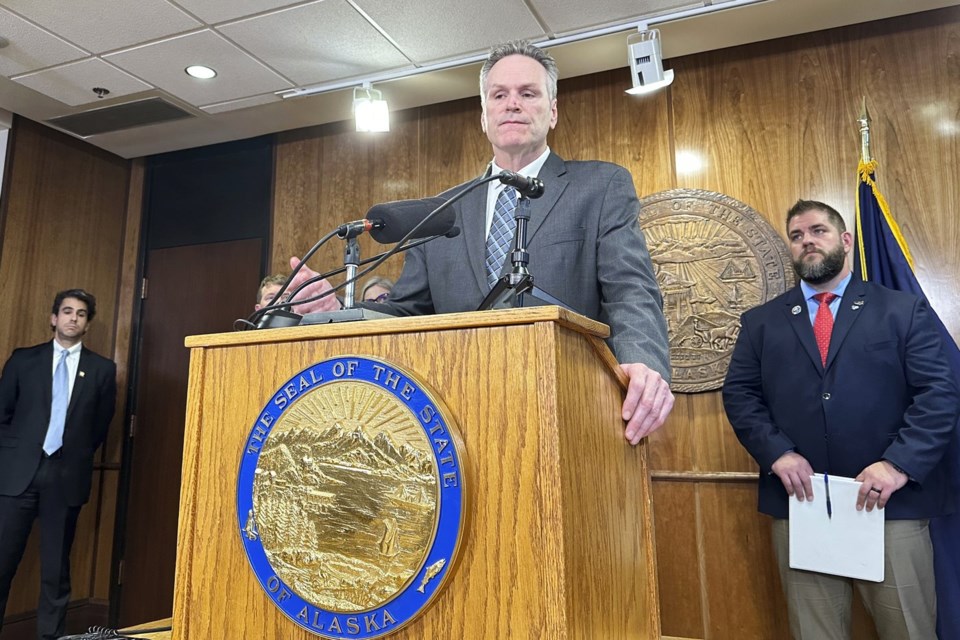JUNEAU, Alaska (AP) — After President Donald Trump returned to office, Alaska Republican Gov. Mike Dunleavy declared “happy days are here again.” He likened Trump’s friendly approach to energy development as “Christmas every day" for a state whose fortunes rise or fall with oil.
But the nearly three months since Trump's inauguration have been tumultuous, roiling Alaska's substantial federal workforce and raising questions about the reliability of federal funding.
And his on-again, off-again tariffs, and a related drop in oil prices, have compounded the uncertainty for Alaska lawmakers, who each year must craft a state budget based on volatile oil prices. The legislative session is set to end in mid-May, well before Trump's recently announced pause on higher tariffs for many countries expires.
The whiplash has worsened long-standing tension over how much money should go toward the yearly oil-wealth fund check most Alaska residents receive as opposed to education or other needs. Lawmakers have shown scant interest in raising taxes and have blown through billions in savings plugging recurring budget deficits dating back more than a decade.
“We're all in a pickle,” said House Speaker Bryce Edgmon, an independent who leads a coalition of Democrats, independents and two Republicans.
Alaska is no stranger to the boom-bust cycle of oil. The government spends more freely on infrastructure and other projects when prices are high and shutters facilities or slashes costs when they are low. Lawmakers base spending off twice-a-year revenue outlooks pegged to oil price and production forecasts.
A year ago, North Slope oil was around $90 a barrel. It settled in the low-to-mid-$70 range beginning last fall and hit as low as $65 this week before Trump announced the 90-day tariff pause.
At current prices, each dollar change in oil equates to about $35 million to $40 million in state revenue, according to the nonpartisan Legislative Finance Division. The March revenue forecast was based on $68-a-barrel oil for the upcoming budget year, down $2 from a December forecast.
Oil prices change frequently and plans by OPEC+ members to add more oil to the market could cause a price softening, said Dunleavy spokesperson Jeff Turner, who noted the governor is focused on Trump's executive order supporting increased oil and gas drilling, mining and logging in Alaska, and that it is "great to have an administration that supports Alaska’s responsible resource development.”
Some state political leaders hope Trump's threatened tariffs could prompt countries like Japan, South Korea and Taiwan to invest in or commit to buying gas from a proposed massive liquefied natural gas project in Alaska. The project, repeatedly touted by Trump, has struggled for years to gain traction amid cost concerns, competition from other projects and questions about its economic feasibility.
Trump carried Alaska in November's election.
Besides oil, Alaska relies heavily on earnings from its nest-egg oil-wealth investment fund. The fund's principal is protected, but its earnings can be spent. Lawmakers cap withdrawals based on a percentage of the fund's average market value over a five-year period. The yearly dividend paid to residents has traditionally come from earnings, but since lawmakers also began using earnings for state services in 2018, there has been friction over how much should go toward each.
Dunleavy proposed a roughly $3,800 dividend per resident, which would cost $2.5 billion — two-thirds of this year's earnings withdrawal — and result in a deficit he suggested covering by tapping the state's diminished savings. That amount hews to a formula abandoned years ago by lawmakers as unaffordable.
The proposal is a nonstarter with legislative leaders, who are hearing pleas for more funding for K-12 schools squeezed by years of inflation and energy and health care costs. Education advocates also want the state to tackle a maintenance backlog that they say has created unsafe learning environments for students, including mold and structural issues at some schools.
Last year, residents received $1,702, a combined dividend and energy relief payment. The dividend the past five years has been as low as $992 in 2020 and as high as $3,284, another combined dividend and energy relief check.
House Majority Leader Chuck Kopp, a Republican, said politicians should not be “even stoking the fantasy” of a dividend as large as Dunleavy proposed.
“We cannot pay an unsustainable dividend, and that dividend distorts the fiscal reality that we’re facing,” he said. “Do we need new revenue, or do we need to get a handle on the size of the dividend we’re paying and honestly figure out how we’re going to prioritize that?”
Some members of the bipartisan-led Senate have urged changes to oil taxes to raise revenue, but overall support has been limited.
Becky Bohrer, The Associated Press



